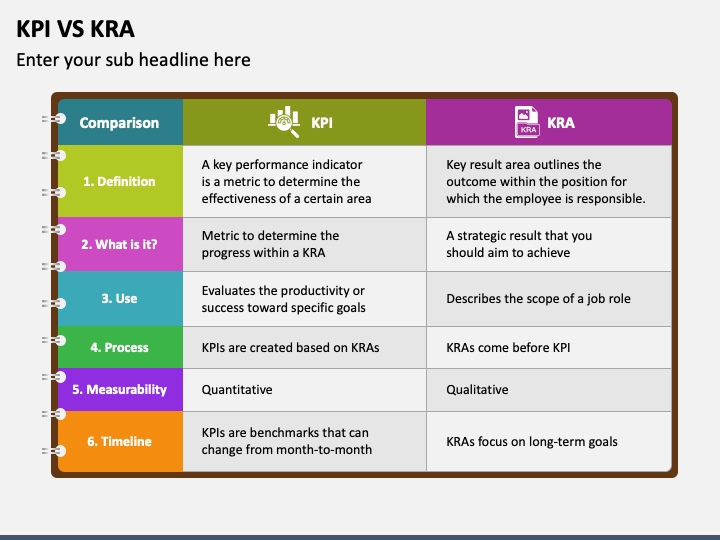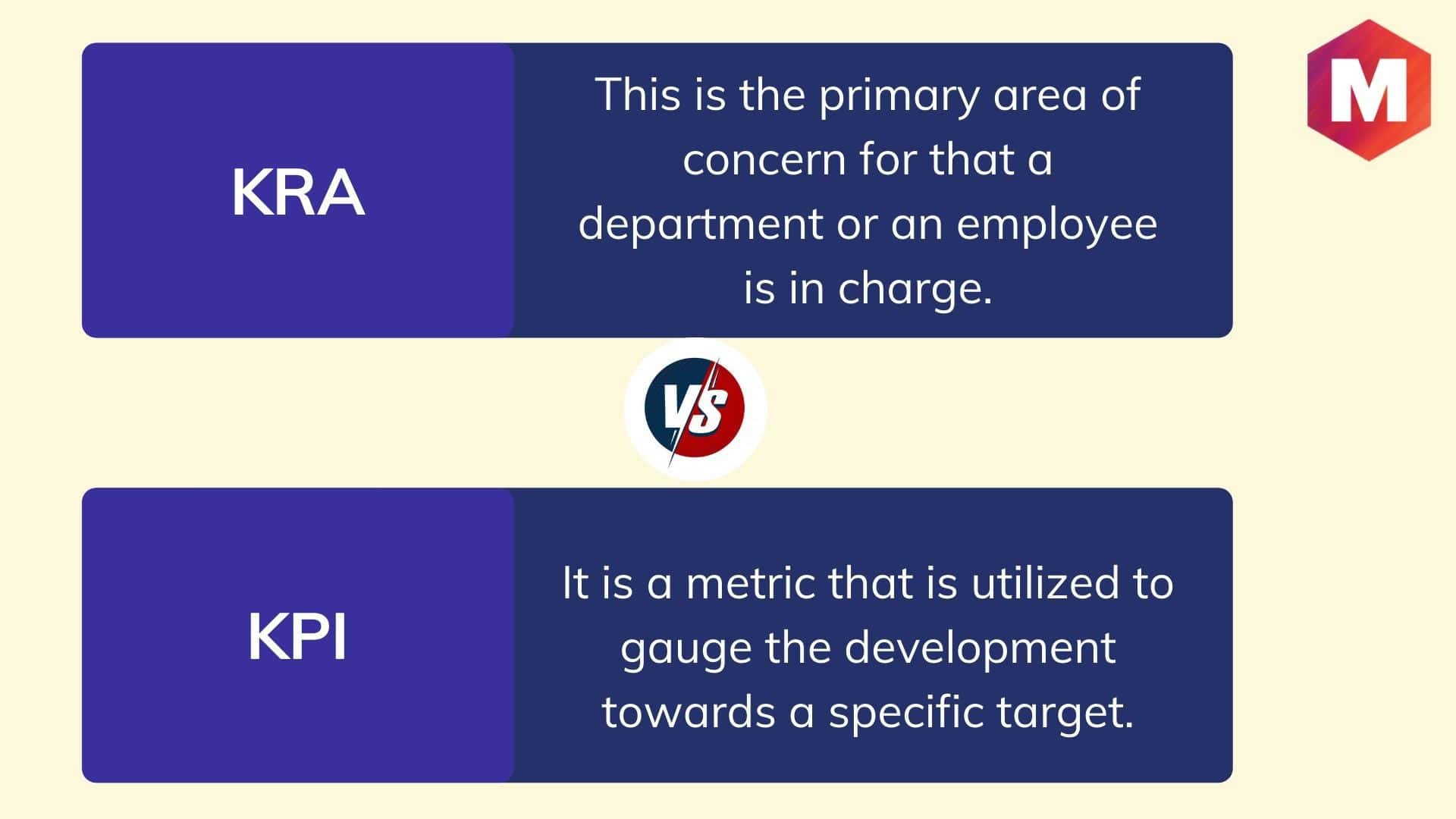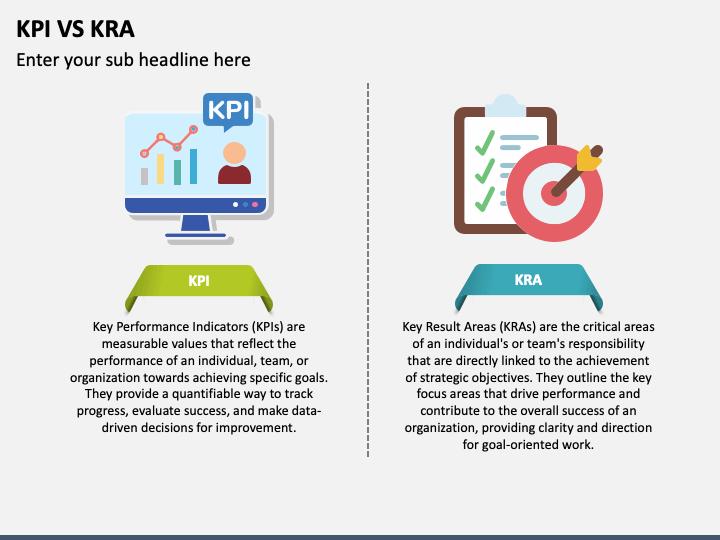Examples of KRAs for marketing managers include the following: Increase percentage of people who buy product after being attracted to the company through marketing. Increase ratio of customers to marketing budget. Decrease marketing costs per new customer acquired.To set the right KRA, identifying the relevant KPI can be essential. Identify the most relevant objectives. Based on the job description and duties, find unique organisational goals that the role accomplishes. List a few core objectives related to the job and others related to other objectives, such as skilling.The full form of KRA is Key Result Area or Key Responsibility Area. KRA is a management concept that defines the job position and duty of an employee, and also refers to the different areas of work for which he may take responsibility.
What is an example of a key performance indicator : An example of a key performance indicator is, “targeted new customers per month”. Metrics measure the success of everyday business activities that support your KPIs. While they impact your outcomes, they're not the most critical measures. Some examples include “monthly store visits” or “white paper downloads”.
What are the 5 KRAs
Here are five potential employee engagement KRAs for HR:
Employee Satisfaction and Feedback. Maintaining and improving overall employee satisfaction is a crucial KRA for HR professionals.
Retention Rate.
Training and Development.
Employee Recognition and Rewards.
Workplace Well-being and Work-Life Balance.
How do you write smart KRA : How to WRITE SMART Goals (KRAs)
Identify the appropriate Organization KPIs where the employee can contribute meaningfully.
Document the responsibilities of the employee in relation to the work they are doing.
The unique responsibilities found in step 2 above will help shortlist KRAs to be used for this employee.
KRAs for each role and organization can differ depending on the task and the business. A well-structured KRA should be detailed, unambiguous, and straightforward. It should be specific, achievable, measurable, relevant, and time-bound for the employees and for the organization's overall growth. Depending on the job profile, experience and expectations, different employees can have different KRAs within the same company. For example, KRA for a sales manager can be the total number of sales in a quarter, while KRA for an HR Manager can be attrition rate and employee satisfaction.
What are the 4 main types of performance indicators
Here are the reasons why these KPIs are picked time and time again:
Customer Satisfaction. It's simple, without customers your organisation wouldn't be here.
Internal Process Quality.
Employee Satisfaction.
Financial Performance Index.
Where to go from here.
Examples of key performance indicators
Gross and net profit margin, which measure how much money a company makes on sales of products.
Inventory turnover, which tracks how quickly products held in inventory are sold.
Cost of goods sold, a measure of the materials and labor costs incurred in making products.
KRAs should be linked to the overall objectives of the organisation and should be related to the specific responsibilities of the employee's role. Goals should be specific, measurable, achievable, relevant, and time-bound (SMART). How To Create KRAs For Your Career Path
Identify your key tasks. First, create a list of your job responsibilities.
Choose a few functions to emphasise.
Set improvement goals.
Determine KPIs for your goals.
How do you write smart kra : How to WRITE SMART Goals (KRAs)
Identify the appropriate Organization KPIs where the employee can contribute meaningfully.
Document the responsibilities of the employee in relation to the work they are doing.
The unique responsibilities found in step 2 above will help shortlist KRAs to be used for this employee.
What is KRA for employee : Key Responsibility Area (KRA) defines the role of an employee. It describes the key roles and responsibilities associated with a job profile. It is well-defined and easy to measure. It helps an employee focus on their job roles and perform better.
Which is better KRA or KPI
KRAs are aligned to the organization's objective. Each job position plays an integral part in achieving the mission statement and vision of the company. KPIs track the progress of an employee/customer towards a set KRA. Therefore, when setting business goals, KRA comes first. Top 3 KPIs to measure your performance management system ROI
Employee Retention.
Employee Engagement.
Employee Productivity.
These metrics—or five Work Performance Indicators (WPIs)—are mix, capacity, velocity, quality, and engagement.
What are the 4 mandatory key performance indicators : Anyway, the four KPIs that always come out of these workshops are:
Antwort What is an example of a KRA? Weitere Antworten – What are KRA examples
Examples of KRAs for marketing managers include the following: Increase percentage of people who buy product after being attracted to the company through marketing. Increase ratio of customers to marketing budget. Decrease marketing costs per new customer acquired.To set the right KRA, identifying the relevant KPI can be essential. Identify the most relevant objectives. Based on the job description and duties, find unique organisational goals that the role accomplishes. List a few core objectives related to the job and others related to other objectives, such as skilling.The full form of KRA is Key Result Area or Key Responsibility Area. KRA is a management concept that defines the job position and duty of an employee, and also refers to the different areas of work for which he may take responsibility.
What is an example of a key performance indicator : An example of a key performance indicator is, “targeted new customers per month”. Metrics measure the success of everyday business activities that support your KPIs. While they impact your outcomes, they're not the most critical measures. Some examples include “monthly store visits” or “white paper downloads”.
What are the 5 KRAs
Here are five potential employee engagement KRAs for HR:
How do you write smart KRA : How to WRITE SMART Goals (KRAs)
KRAs for each role and organization can differ depending on the task and the business. A well-structured KRA should be detailed, unambiguous, and straightforward. It should be specific, achievable, measurable, relevant, and time-bound for the employees and for the organization's overall growth.

Depending on the job profile, experience and expectations, different employees can have different KRAs within the same company. For example, KRA for a sales manager can be the total number of sales in a quarter, while KRA for an HR Manager can be attrition rate and employee satisfaction.
What are the 4 main types of performance indicators
Here are the reasons why these KPIs are picked time and time again:
Examples of key performance indicators
KRAs should be linked to the overall objectives of the organisation and should be related to the specific responsibilities of the employee's role. Goals should be specific, measurable, achievable, relevant, and time-bound (SMART).

How To Create KRAs For Your Career Path
How do you write smart kra : How to WRITE SMART Goals (KRAs)
What is KRA for employee : Key Responsibility Area (KRA) defines the role of an employee. It describes the key roles and responsibilities associated with a job profile. It is well-defined and easy to measure. It helps an employee focus on their job roles and perform better.
Which is better KRA or KPI
KRAs are aligned to the organization's objective. Each job position plays an integral part in achieving the mission statement and vision of the company. KPIs track the progress of an employee/customer towards a set KRA. Therefore, when setting business goals, KRA comes first.

Top 3 KPIs to measure your performance management system ROI
These metrics—or five Work Performance Indicators (WPIs)—are mix, capacity, velocity, quality, and engagement.
What are the 4 mandatory key performance indicators : Anyway, the four KPIs that always come out of these workshops are: